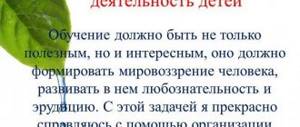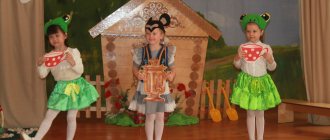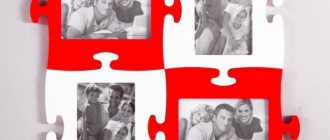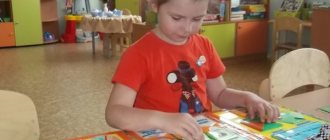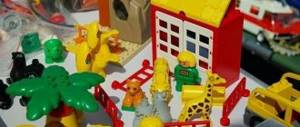According to modern requirements of the Federal State Educational Standard, the creative activity of preschool children in preschool educational institutions is the leading method of training and development of preschool children.
Creative activity is considered to be this type of child activity, during which creative cognition and transformation of oneself and the surrounding reality are carried out.
Among the types of creative activity of preschoolers, two can be distinguished: arts and crafts and artistic and aesthetic.
Decorative and applied arts include the following types of creative activities: drawing, sewing, macrame, designing and modeling.
Artistic and aesthetic creative activities include the following types: music, vocals, choreography, theatrical games and oral creativity .
In addition to the fact that the creative process captivates the child and takes up his free time, artistic activity also allows the preschooler to express his interests and experiences.
Creative activities of children in preschool educational institutions
The creative activity of preschoolers consists of classic child activities. The very first and main thing is drawing, followed by modeling and design. Also a common type of artistic activity in preschool educational institutions is the retelling of children's works and participation in theatrical performances.
Fine arts in preschool educational institutions
Children's drawings are a reflection of reality through the eyes of a child.
In fine art, a preschooler realizes his fantasies and emotions. By analyzing the colors that a child uses to create his drawing, you can immediately understand what he feels sympathy for and what he does not like. Fine arts also include modeling from plasticine and clay, appliqués and decorative arts. Thanks to such activities, the child learns to translate a plan into reality, to tangibly perceive the shape, volume and size of objects.
By trial and error, thinking about how to recreate what was planned in reality, the child gains experience and develops skills in working with a particular material or tool.
Design at preschool educational institutions
Design is an independent creative activity of a preschooler, during which he creates a new product. A child’s constructive creativity lies in the formation of a plan and the stages of its implementation. Preschoolers enjoy the process of assembling construction kit parts and resulting in small models of real objects - furniture, cars, buildings.
Unlike working with a construction set, where creativity is carried out only on the child’s initiative, paper construction is creativity based on a model, the initiative of which belongs to an adult. In artistic construction from paper, the child takes part together with the teacher, observes and repeats his every action.
The technique of working with paper can be different: cutting, tearing, bending, creasing.
The most popular types of paper crafts are origami and paper sculpture.
Origami is a paper folding technique that results in the creation of paper figures of birds, animals, and objects.
Paper sculpture is a type of artistic creativity in which a craft is created from a combination of different paper forms, united by one theme or design, made by children with their own hands.
Artistic and speech activity of preschoolers
In early preschool age, a child’s artistic and speech activity consists of listening to children’s artistic and poetic text.
In middle and adult preschool age, the child’s artistic and speech activity becomes active and is expressed in the retelling of a listened work or a story about what happened to the main characters, what traits of their character or appearance attracted the child’s attention.
The retelling can be built in the form of a dialogue, where the teacher asks questions and the preschooler gives answers to them.
A more complex form of artistic and speech activity of a child is setting him the task of independently inventing a story, creating a plot and choosing characters.
Theatrical games are always enthusiastically received by children and are of great value in the development of creative and speech abilities of preschoolers. The process of assigning roles, studying the character of one’s character and the performance itself is very captivating for the child, allowing him to realize his fantasies and express himself.
Dance and music activities in preschool educational institutions
Dance and music classes are necessary for preschoolers to develop their sense of tact and rhythm or musical abilities already inherent in nature.
During dance and music classes, the child becomes active and organized. During rhythmic exercises, the child’s movement is organized, his plasticity is formed, and interest in physical activity is stimulated.
While listening to musical works with the help of a teacher, the child develops associative and figurative thinking skills caused by the sound of the melody.
It is very important for a teacher to have casual conversations with a preschooler and ask him to share his impressions caused by a piece of music. You can also combine a music lesson with fine arts and invite students to draw the associations that they have.
Children's performing creativity is expressed in the expressiveness and individual manner in which a preschooler performs songs and dances. In the case where a child is the author of a dance or musical motif, the preschooler’s creativity is of a compositional nature .
Why is creative activity needed in a preschool educational institution?
The creative activity of preschool children influences the development and formation of the child’s aesthetic and cognitive perception of the world around him.
Through creativity, the child gets an impression of what an object looks like, its shape, size and content, basic information about taste, color, texture and sound is formed, and an artistic perception of works of musical, literary and visual art develops.
Chapter VII. ARTISTIC ACTIVITY OF PRESCHOOL CHILDREN
⇐ PreviousPage 12 of 43Next ⇒
Artistic activity, like play, is typical for preschool age. Preschoolers enjoy drawing, sculpting, designing, doing applique work, dancing, singing, listening to fairy tales, reading poetry, and dramatizing their favorite works.
The development of artistic activities is facilitated not only by their accessibility and attractiveness, but also by some age-related characteristics of children. These include the “reactivity” of children to “immediate impressions delivered by the senses,” “sensitivity to figurative and emotional moments” (N. S. Leites), and the relationship between the first and second signaling systems characteristic of this period. “Children in general are close to the so-called “artistic” type, which is characterized by vividness of perception, visual, figurative memory, richness of imagination and some lack of abstract thinking”[76].
Artistic activity develops throughout preschool childhood, and it becomes especially active towards the end of preschool age. During the transitional period to school, a special form of developed play appears—dramatization play—a kind of “pre-aesthetic” activity.
A. N. Leontiev identifies the following as its characteristic features: 1) unlike earlier games, it does not reflect the generalized actions of the depicted hero, but reproduces what is “typical of him”; 2) direct imitation is replaced by arbitrary creative construction; 3) for the child, it becomes important not only the role that he takes on (who he portrays, what), but also how perfect the transfer of objective content expressed in a specific role is. All this gives reason to consider the dramatization game “one of the possible forms of transition to productive, namely aesthetic, activity with its characteristic motive of influencing other people”[77].
The motives for artistic activity are specific. One of the characteristic distinctive aspects of the motivation of artistic activity is communication through art. Of course, preschool age is only the prehistory of this type of communication. But it is important to create the prerequisites, the beginnings of communication through art, already in childhood.
Let's consider some types of artistic activities of preschool children.
Preschooler drawing
There are various types of visual activities for preschoolers. A special place among them belongs to drawing. Children's drawing has long attracted the attention of scientists; special interest in it arose in the 80s and 90s. XIX century Psychologists, teachers, historians, ethnographers, and art historians simultaneously show interest in children's drawings. From the very beginning of child psychology, a child’s drawing was considered one of the means for exploring his mental world. One of the first researchers of children's drawings in Russia, the famous psychologist and psychiatrist V. M. Bekhterev, back in the early 20th century. Drawing the attention of his colleagues to children’s drawings, he noted that drawing “...is an extremely instructive subject of research.”
Children's visual creativity is aimed at depicting the surrounding reality. However, the child does not reflect the real world mechanically in the products of his activities. This reflection is complexly determined by the entire course of the child’s mental development, his age and individual characteristics, living conditions, upbringing, training (E. I. Ignatiev, E. A. Flerina, V. S. Mukhina, N. P. Sakulina, T. S. Komarova, etc.).
By drawing, the child shows his desire to understand the world around him and, to a certain extent, the level of this knowledge. The more developed a child’s perception and observation skills are, the wider his stock of ideas, the more fully and accurately they reflect reality in their creativity, the richer and more expressive their drawings. The visual activity of a preschooler reflects such specific features of his thinking as concreteness and imagery (depicting Leningrad under the siege, children drew a city surrounded by wire (“They broke the blockade, removed the wire, hurray!”). The child’s visual activity is closely connected not only with individual functions (perception, memory, thinking, imagination), but also with the personality as a whole. It shows the child’s interests, temperament, and some gender differences. Boys, for example, like to draw soldiers, horses, vehicles (ships, trains, airplanes) , racing horsemen; girls prefer to depict houses, nature. Boys are more inclined towards dynamic structures, while girls are more inclined towards static images, they more often use ornamental and decorative design, decoration in their drawings.
The quality of a child’s drawing is affected by the child’s health, his general physical and mental state. Thus, N.N. Burmistrova revealed that in preschool children with scarlet fever, there seems to be a degradation of visual skills and abilities, their drawings become more primitive, the child often switches to a plotless drawing, moves away from the use of color, subtle differentiations and moves to colorless or a drawing that is inadequate in its use of color. During the process of recovery, the child’s visual activity gradually becomes more complex, reaching, as a rule, the level at which it was before the disease.
The drawings of children with mental illness have their own characteristics. Thus, preschool children suffering from schizophrenia are characterized by incompleteness in the depiction of objects and actions, a sharp deformation of the form, an increase in anatomical parts, disproportion, geometrization, mixed projection, pretentiousness, discontinuity in the image, clutter, layering, unusual themes, pathological attraction to the image certain objects, paradox in the depiction of the characters in the plot and some other features[78]. The revealed dependence of the quality of the drawing on the state of the child’s health makes it possible for specialists to use children’s drawings as a diagnostic method.
The emergence of a child’s visual activity is preceded by a preparatory period (see Chapter V, § 2). At this stage, when creating doodles, the child does not yet set a pictorial goal.
Particularly significant in the development of visual activity is the period when the child begins to set himself a visual task. At the same time, his drawing moves into a new stage - the stage of visual activity itself.
Improving visual activity is associated with the development during preschool age of the mechanisms of visual-motor coordination and visual-motor readiness for drawing.
The drawing process, as a rule, is accompanied by the child’s story and verbal designations of the depicted objects. Verbal designations help the child identify their characteristics in objects. In the first steps of mastering visual activity, the word is an essential “additive” to a child’s drawing. As you master the language of graphic representation, the drawing acquires more and more independent meaning, the need for verbal additions to it gradually decreases. Words begin to primarily have a regulatory function, planning the process of depiction, controlling the methods and techniques of depiction.
One of the most characteristic features of a preschooler’s drawing is its schematism. Thus, when depicting a person, children often draw a “cephalopod” (head, arms, legs). Specific features of the style of children's drawing also include “transparency”, “unobscuredness” of the object (when drawing a house, a child often depicts it simultaneously from several points of view - walls, roof, door, fence and people, furniture through seemingly “transparent” walls).
“In response to the teacher’s remark about the child’s drawing “Why are apples visible in a closed basket?” the child answers: “And I opened it and looked, there were a lot of them, my mother brought them from the market” (from the research of E. A. Flerina).
In a drawing, the child strives to convey all his knowledge about the subject. He finds it difficult to convey the dynamics of objects. Often children (most often younger preschoolers) find a way out of it in onomatopoeia and gestures. From motor and involuntary dynamics, the child gradually moves to visual, depicted dynamics.
It is also difficult for a child to convey perspective abbreviations, proportionality of individual parts of an object, etc.
Throughout preschool age, under the influence of learning, the development of mental functions, and the acquisition of experience, the child’s drawing becomes richer in content, more detailed, and expressive.
In recent years, in child psychology, a child’s drawing is increasingly viewed as a synthetic activity, characterized by the manifestation of different aspects of mental development, the use of experience acquired in different types of children’s activities, and the assimilation of heterogeneous elements of social experience and human culture[79].
In the drawing, the child not only shows his level of knowledge of the world, but also expresses his emotional attitude towards the environment. The content of the drawings already indicates the child’s preferences, what particularly interests and attracts him.
In children's drawings we will see a merry holiday, a circus that amazed the child with its colorfulness and unusualness, his favorite Petrushka, the characters of a fairy tale, story, movie that excited him, brave, strong cosmonauts, pilots, firefighters. The most important events and phenomena that resonate in the child’s soul and are significant to him are reflected in his creativity.
The main means of expressing the attitude towards the image are line and color. Moreover, color in the preschool period is more often used in an expressive sense than in a visual sense. In addition, the child uses ornament and symmetrical structures, exaggeration or understatement of individual objects, and composition as special means of expression[80].
Children painted Soviet ships as proudly handsome during the Great Patriotic War, Soviet planes as beautiful birds, our tanks as huge, victorious, and fascist ones as gloomy, small, and ugly.
“I just can’t draw a Red Army soldier,” says the boy, “I always end up with a fascist.”
- Why? - So ugly...
Shurik drew our plane and asks for another sheet of paper: “I don’t want to draw a fascist plane on the same sheet of paper as ours” (from the diary of kindergarten teachers in Leningrad)[81].
To study the emotional attitude of preschoolers to the world around them, as a rule, drawings are analyzed on topics that in themselves require children to express their own attitude to reality (“The most beautiful”, “The ugliest”, “The funniest”, etc.). P.).
While studying drawings on the themes “The Most Beautiful” and “The Most Ugly,” V.S. Mukhina drew attention to the following: three-year-old children almost all immediately began to depict “the most beautiful.” Younger preschoolers depicted only what they knew how to do and preferred. The proposal to draw “the ugliest thing” caused great difficulties - the children either refused to draw the ugliest, or found a way out in pre-figurative sketching, without effort. Starting from the age of five, children amaze with their independent and varied solutions to given topics. For children, what is beautiful is what gives pleasant visual impressions (bright colors: yellow, orange, red, blue, emerald green), ornaments, emotionally experienced natural phenomena, pleasant animals, good actions of people approved by others, the results of human activity, unfulfilled wishes. Ugly - everything unpleasant, scary, frightening in reality and in fairy tales (wolf, devils); actions that are condemned, roars, dirty, etc. Ugly things are often decorated with dark (black, brown, etc.) colors.
In preschool age, children look for expressive means not only in their own activities. They begin to master the expressive means of the dominant artistic movements in their environment, assimilate social experience and apply it in their visual creativity. “The child,” emphasizes V.S. Mukhina, “appropriates expressive means in the same way as the entire spiritual culture of the society in which he lives”[82].
⇐ Previous12Next ⇒
Recommended pages:
Organization of artistic and creative activities for preschool children
Artistic and creative activities have a beneficial effect on developing independence in preschoolers. The first steps in this direction are represented by the organization of visual activities. With the help of drawing, the child independently expresses his impressions and ideas about reality obtained under different circumstances.
In order to organize independent artistic and creative activities of children, preschool groups must have a place for creative activities, equipped with: - visual and plastic materials; - paper of different colors, formats, textures; — applicative material (scissors, glue, rulers); - stencils, silhouettes; — didactic material, samples, diagrams, cards.
Workplaces organized in this way allow children to independently choose the direction of creative activity in accordance with their desires and interests, and provide new opportunities for the development of the child’s creative potential within the framework of preschool education.
Organizing a child’s creative activity through play is considered by teachers to be the most successful. During role-playing play, the preschooler copies and imitates what he observes in real life, and at the same time subjects his own impressions to creative processing, gives vent to his imagination, brings his artistic idea to life, and learns to look at the situation from different points of view.
The creative activity of a preschooler is organized by a teacher who must:
- clearly pose the problem to the students;
- create a situation in which the child can independently identify existing problems;
- create a situation with a more or less clearly defined problem and allow the child to independently find ways to solve it.
When conducting creative activities with preschoolers, the teacher should take the position of an observer and unobtrusively correct the child’s actions if such a need arises. In creative activities, a preschooler should have freedom of self-expression, and not adopt the thinking patterns of an adult.
Independent speech activity
Inna Meleshina
Independent speech activity
Independent speech activity.
The content of work on the development of artistic and speech activity of preschoolers includes familiarizing children with works of fiction, teaching retelling, and developing the initial forms of verbal creativity.
One of the most advanced forms of implementing independent speech activity in a preschool institution is theatrical play. It presupposes children's knowledge of the text of a literary work; improvisation in words and intonation, action, gesture, facial expressions when playing a role. Attributes and decorations selected by the children or specially made by them themselves with the help of the teacher are desirable; sound, noise, musical and rhythmic accompaniment, etc.
The predecessors of theatrical games in kindergarten are dramatizations of literary texts and games - dramatization. Dramatizations are most often carried out as children reading a text in roles. The teacher plays the role of presenter and says the text “from the author”
. Sometimes dramatization includes actions with tabletop and finger theater figures; flannelgraph can be used.
In the game - dramatization, the pronunciation of the text is accompanied by game actions. In cases where children improvise well, portraying the hero of a literary work and conducting a monologue or dialogue almost independently .
Theatrical games are based on dramatizations and games - dramatizations, which are more complex in content, preparation and organization. In a theatrical game, as a rule, all the pupils of the group are involved: some as the main ones (leaders)
performers (2-3 compositions, and others as participants in crowd scenes.
Theatrical games are carried out only with older preschoolers, but starting from the first junior group, systematic and purposeful work is necessary to develop children's intonation expressiveness of speech, the formation of the ability to imitate human gestures and animal movements. In the program repertoire of literary works for younger preschoolers there are quite a lot of nursery rhymes that attract the child with their rhythm and playful content; fairy tales When reading a nursery rhyme to children, dramatizing an excerpt from a fairy tale, the teacher also shows play actions, encouraging the kids to perform them first with him, and then independently . In the evening, you can invite a child who willingly improvised in class to show his mother (grandmother)
.
During the independent games, the teacher brings toys into the group room that will remind them of this or that work of art and make them want to dramatize it.
The teacher monitors the children’s improvisations during their independent role-playing games, praises them for successful imitation, suggests and shows new artistic solutions (rocking a bear or doll, singing a lullaby; depicting how a kitten washes itself, purrs, etc.).
In the second younger group, children are specially taught to depict a situation described in a literary text. Several children can be involved in the performance at the same time, playing different roles. So, the teacher recites the Russian folk song “Tili - bom...”
: “...A chicken is running with a bucket, and a horse is running with a lantern, and a dog is running with a broom, and a gray bunny is running with a leaf. Once! Once! Once." And the children show what the characters are doing.
“Three Bears” fairy tales are staged.
,
“Masha and the Bear”
,
“Rukavichka”
(first in direct educational
activities , then in free time).
Children immediately join the game if they see attributes made to dramatize a particular fairy tale. The participation of the teacher makes dramatization especially attractive to children. Dramatizations should be more widely included in holiday matinee scenarios. In the middle group, the independent artistic and speech activity of preschoolers becomes much more perfect, since children already possess certain skills and abilities. By telling, reciting, or depicting something, children of the 5th year of life try to achieve a certain result, and are sensitive to the advice and wishes of the teacher. For direct educational activities and free time, special tasks are planned - games, the purpose of which is to exercise children in acquired skills and abilities. For example, preschoolers depict a bunny who is stuck to a tar bull and cannot free himself (fairy tale “The Tar Bull”
, piglets frolicking on the lawn (fairy tale
“The Three Little Pigs”
, etc.
You can have someone prepare the improvisation in advance and then show it to your peers. So, the child turns to his friends: “Do you want to see how the hamster washes itself?”
The teacher must reward students for their ability to observe, notice characteristic details, and the originality of their improvisations.
In games - dramatizations, many children in the 5th year of life lose the visual solutions they have found, since simultaneous pronunciation of the text and game actions enter into a competitive relationship. By the end of senior preschool age, it is possible to achieve a certain synchrony between word and gesture.
Theatrical performances, in which pupils of all groups participate, contribute to the comprehensive development of children and the strengthening of friendly relationships in the team of a preschool institution.
It is better if the main participants in the performance are children of middle and senior preschool age. The oldest students, together with the teacher, will help stage and design the most complex numbers of the performance.
The success of a performance often depends not only on how it is prepared, on the quality of the script, but also on some seemingly significant points. So, the performance should not be delayed. The optimal time is 25 – 35 minutes. Number of spectators and participants – 2 – 3 groups and guests – adults. It is important that all children are involved throughout the performance. It is also necessary to provide techniques that allow the audience to become active participants in the performance: you can invite the guests to say something out loud (a magic spell like “Crible-crable-boom!”
, sing, clap your hands to the beat of the melody, etc.
At the end of the performance, it is advisable to introduce to the audience everyone who took part in its preparation and performance, and tell what exactly was done by each child.
Children of senior preschool age are taught to invent fairy tales, introducing new characters into the familiar plot. The teacher listens to the fairy tales himself or assigns this work to the jury. The jury decides on the most interesting versions of fairy tales. With the best fairy tales (2-3)
the authors perform at entertainment evenings and birthday celebrations.
Children prepare gifts for kindergarten staff for national holidays and anniversaries. The teacher explains how it is customary to give a gift, what can be said, and involves the students in discussing the congratulation scenario (what and how should be done so that all the children congratulate, what words can be said in chorus, what can be sung, etc.).
The acquired skills are consolidated and improved in children’s independent games , in particular in board and printed games.
It is advisable to make special “magic”
cubes of the type that are used to repeat program material on the sound culture of speech.
Pictures are pasted on the sides of the cubes. The driver turns the cube with his eyes closed. “Spin, spin, lie on your side
,” the children say.
“stop”
signal , the driver stops the cube, opens his eyes and, focusing on the top picture, depicts what is drawn there. He can imagine the plot and develop it. For example, the picture shows a hedgehog and a mushroom next to it. A child, pretending to be a hedgehog, shows how he chewed the stem of a mushroom, pinned it and carried it away. Children evaluate the performance and decide whether they can give the performer a chip. Then, using a counting rhyme, a new driver is selected. The winner is the one who has the most chips at the end of the game.
Illustrations of poems and fairy tales familiar to children can be pasted on the faces of the cubes. In this case, the driver must read the poem by heart and retell one of the episodes of the fairy tale quite fully and expressively.
Children of the 6th and 7th year of life can independently ask each other riddles. This independent speech activity takes place in the form of a game. Having guessed a riddle, the child receives a chip. The preschooler who finds the answer before others also gets a chip. The one who collects the most chips wins. Each participant in the game has the right to make no more than three riddles
Games that allow children to practice pronouncing tongue twisters and counting rhymes are useful. For such a game, you should select 2 pictures, the content of which will tell the child what he needs to remember and tell. For example, one picture may show children standing in a circle and one in the center (choice of the driver using a counting rhyme)
.
Another picture may show children telling something (the child who received this picture will have to say a tongue twister)
.
4 or 6 people play, divided into 2 groups. Children sit at a table on which pictures are laid out under napkins, or stand around it. Everyone takes turns taking out pictures from under the napkins and completing the corresponding tasks. If a child pronounces a tongue twister or counting rhyme correctly, clearly, at the right pace, he receives two chips. If he makes an inaccuracy, then only one. For a new one (unfamiliar to everyone)
counting rhyme, tongue twister turns out to be an additional feature. The group with the most chips wins.
First, the teacher leads the game. It helps children learn the rules and monitor their implementation. Next, the role of the judge (arbitrator)
entrusted to the child.
Printed board games are an effective means of developing explanatory speech. First, the teacher helps children who are not talkative and lack initiative learn the rules of the new game. Then he asks them to explain the rules to their friends and then to anyone who wants to learn the game.
It is necessary to provide children with the opportunity to use the acquired tasks and skills in non-standard conditions. An example of the latter are holiday matinees and entertainment evenings. Older preschoolers should not only actively participate in events organized by adults, but also help teachers lead the holiday. In particular, they can invite peers or younger children to compete in speed and dexterity, solving riddles, solving various logical problems, pronouncing tongue twisters, etc.
